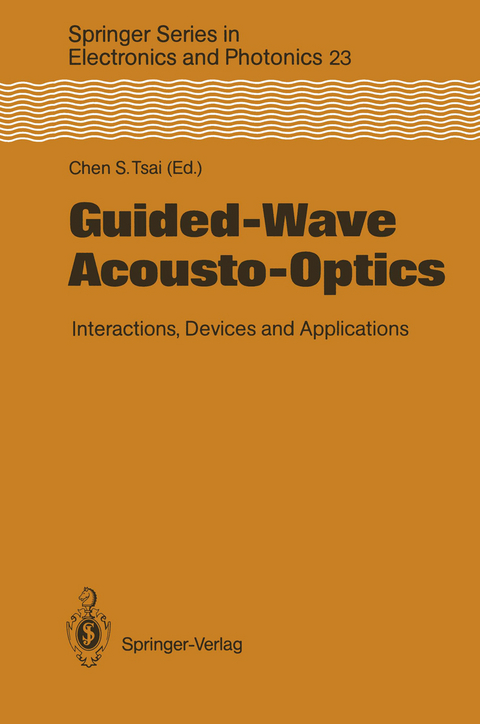
Guided-Wave Acousto-Optics
Springer Berlin (Verlag)
978-3-642-75227-8 (ISBN)
Guided-Wave Acoustooptics reviews Bragg interactions between guided optical waves and acoustic waves, both in terms of basic theory and in the substrates LiNbO3, ZnO/SiO2 and GaAs, as well as the sideband modulators and deflectors that can be manufactured with this technology. Further applications described include light beam modulation and deflection, multiport switching in communications and spectral analysis, correlation and convolution in RF signal processing.
1. Introduction.- References.- 2. Bulk-Wave Acousto-Optic Bragg Diffraction.- 2.1 A Simple Experiment.- 2.2 Historical Perspective.- 2.3 Heuristic Picture.- 2.4 Parametric Excitation and Bragg Diffraction.- 2.5 A Quantum-Mechanical Point-of-View.- 2.6 Wave Theory.- 2.7 A Sample Calculation.- 2.8 The Reflection Case.- 2.9 Birefringent Bragg Diffraction.- 2.10 Acousto-Optic Materials.- 2.11 Conclusion.- References.- 3. Optical Waveguides - Theory and Technology.- 3.1 Background.- 3.2 Wave Equations and Wave Vectors.- 3.3 The Zigzag-Wave Model.- 3.4 The Potential-Well Model.- 3.5 Mode Equations of a Slab Waveguide.- 3.6 Mode Equations of a Channel Waveguide.- 3.7 Effective-Index Method.- 3.8 Diffused Waveguides and the WKB Method.- 3.9 Waveguide Materials.- References.- 4. Excitation of Surface-Acoustic Waves by Use of Interdigital Electrode Transducers.- 4.1 Fundamentals of Transducer Operation.- 4.2 Design of Transducer and Coupling Networks for Broad-Band Operations.- 4.3 Summary.- References.- 5. Wideband Acousto-Optic Bragg Diffraction in LiNbO3 Waveguide and Applications.- 5.1 Guided-Wave Acousto-Optic Bragg Interactions in Planar Waveguides.- a) LiNbO3 Substrate.- b) GaAs Substrate.- c) SiO2, AS2S3 or SiO2-Si Substrates.- 5.2 Key Performance Parameters of Basic Planar Acousto-Optic Bragg Modulators and Deflectors.- 5.3 Guided-Wave Acousto-Optic Bragg Diffraction from Multiple Surface Acoustic Waves.- a) Tilted-SAWs Configuration.- b) Phased-SAWs Configuration.- 5.4 Realization of Wide-Band Planar Acousto-Optic Bragg Modulators and Deflectors.- a) Isotropic Diffraction with Multiple Tilted Transducers of Staggered Center Frequency.- b) Isotropic Diffraction with Phased-Array Transducers.- c) Isotropic Diffraction with Multiple Tilted.- Phased-Array Transducers.- d)Isotropic Diffraction with a Single Tilted-Finger, Chirp Transducer or an Array of Such Transducers.- e) Optimized Anisotropic Diffraction with Multiple Transducers of Staggered Center Frequency or a Parallel-Finger Chirp Transducer.- a) Isotropic Device with Multiple Tilted Transducers of Staggered Center Frequency.- b) Isotropic Device with Multiple, Tilted Transducers of Improved Geometry.- c) Isotropic Device with Phased-Array Transducers.- d) Isotropic Device with a Tilted-Finger, Chirp Transducer.- e) Optimized Anisotropic Device with a Single Transducer of Large Aperture.- 5.5 Applications in Optical Communications, Signal Processing, and Computing.- a) Digital Deflection and Switching.- b) Analog Deflection and Switching.- c) Electronically Tunable Optical Wavelength Filtering.- d) Wide-Band Optical Frequency Shifting.- a) Spectral Anlysis of Very Wide-Band RF Signals.- b) Convolution of Wide-Band RF Signals.- c) Compression of RF Chirp Pulse.- d) Correlation of Wide-Band RF Signals.- 5.6 Summary.- References.- 6. Guided-Wave Acousto-Optic Interaction in a ZnO Thin Film on a Nonpiezoelectric Substrate.- 6.1 Fabrication of ZnO Thin Film.- 6.2 The ZnO Thin-Film Waveguide.- 6.3 Excitation of SAW by ZnO Thin Films.- 6.4 Photoelastic Effect in ZnO.- 6.5 Acousto-Optic Interaction in ZnO Thin Film.- 6.6 Combined Structure of ZnO and Other Thin Films.- References.- 7. Spectrum Analysis with Integrated Optics.- 7.1 Acousto-Optic Spectrum Analysis.- 7.2 The Integrated Optical Spectrum Analyzer.- 7.3 Components.- a) Semiconductor Diode Laser Characteristics.- b) Butt-Coupling.- a) Silicon.- b) Lithium Niobate.- a) Generalized Waveguide Luneburg Lens.- b) Diffraction Lenses.- c) Geodesic Lenses.- a) Frequency Dependence of the Diffraction Efficiency.- b) Wideband Transducer Configurations.- c) SAW Attenuation.- a) Detector Array Architecture.- b) Post-Detection Processing.- c) Detector Sensitivity.- d) Dynamic Range.- e) Speed.- f) Photodetector Pitch.- g) Photodetector Coupling.- 7.4 IOSA Demonstrations.- 7.5 Related Applications.- 7.6 Summary.- References.- 8. Integrated Acousto-Optic Device Modules and Applications.- 8.1 RF Spectrum Analyzer Modules in Nonpiezoelectric Substrates.- 8.2 Acousto-Optic Time-Integrating Correlator Module Using Anisotropic Bragg Diffraction.- 8.3 Crossed-Channel Waveguide Acousto-Optic Modulator/ Deflector and Frequency-Shifter Modules.- 8.4 Channel-Planar Composite Waveguide Acousto-Optic Bragg Modulator Modules.- 8.5 Multichannel RF Correlator Modules Using Acousto-Optic and Electro-Optic Bragg Diffractions.- 8.6 Planar-Waveguide Acousto-Optic Frequency-Shifter Module.- 8.7 GaAs Acousto-Optic Bragg Cell and RF Spectrum Analyzer Modules.- 8.8 Spherical Waveguide Acousto-Optic Bragg Modulator/ Deflector and Frequency-Shifter Modules.- 8.9 Conclusion.- References.
| Erscheint lt. Verlag | 25.12.2011 |
|---|---|
| Reihe/Serie | Springer Series in Electronics and Photonics |
| Zusatzinfo | XIII, 322 p. |
| Verlagsort | Berlin |
| Sprache | englisch |
| Maße | 155 x 235 mm |
| Gewicht | 516 g |
| Themenwelt | Naturwissenschaften ► Physik / Astronomie ► Optik |
| Technik ► Elektrotechnik / Energietechnik | |
| Technik ► Nachrichtentechnik | |
| Schlagworte | Apertur • Design • Development • diffraction • Electrical Engineering • Integrated optics • Material • Modulator • Network • Optical Information Processing • Optics • Planar • Research • semiconductor • Signal Processing • Technology |
| ISBN-10 | 3-642-75227-6 / 3642752276 |
| ISBN-13 | 978-3-642-75227-8 / 9783642752278 |
| Zustand | Neuware |
| Haben Sie eine Frage zum Produkt? |
aus dem Bereich


